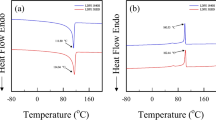Summary
The character of the surface and bulk properties of polyethylene have been considered with respect to adhesion and bond strength. Rupture of adhesion oxidatively activated polyethylene to aluminum has two faces. One of them is an apparent failure at the interface of aluminum-polyethylene which was moderately oxidized and another is the failure at the surface region of polyethylene which was strongly oxidized. In the former case the introduction of polar groups with oxidation is effective for the promotion of bond strength, and from the increasing behavior of bond strength we conclude that the adsorption theory on adhesion is appropriate for the elucidation of adhesion mechanism.
Zusammenfassung
Oberflächenverhalten und Eigenschaften von Polyäthylen wurden hinsichtlich Adhäsion und chemischer Bindungsfestigkeit diskutiert. Der Bruch von Adhäsionsbindungen zwischen oxydativ aktiviertem Polyäthylen und Aluminium hat zwei Seiten: Einmal spielt die Konzentration an Fehlbaustellen in der Grenzfläche Aluminium/Polyäthylen, nämlich wenn letzteres schwach oxydiert, eine Rolle. Zum anderen ist die Struktur des gesamten Oberflächenbereichs des Polyäthylens bis zu einer gewissen Tiefe gestört, wenn letzteres stark oxydiert. Im ersten Fall wirkt die Einführung von Polyäthylengruppen durch die Oxydation bindungsfördernd. Und aus dem Anwachsen dieser Art Bindungsfestigkeit schließen wir, daß die Adsorption für die Erklärung des Adhäsionsmechanismus eine Rolle spielt und damit eine Adsorptionstheorie für die quantitative Fassung der Adhäsion im entsprechenden Rahmen angemessen ist.
Similar content being viewed by others
References
McLaren, A. D., Adhesion and Adhesive 57 (1954) Soc. Chem. Ind. (London 1954).
Shaden, W. H., M. J. Bodnar, Plastic Technology3, 988 (1958).
Rossmann, K.: J. Polymer Sci.19, 141 (1965).
Motoki, I. andF. Tokimitsu, Paper represented at the 4th Symposium on Adhesion and Adhesives. June (1966) Osaka.
Bockhoff, F. J., E. T. McDnel andJ. E. Rutzler, Jr., Ind. Eng. Chem.50, 904 (1958).
Nakao, K., M. Nishiuchi, J. Adhesion Soc., Japan2, 239 (1966).
Saito, K., Chemedine-Review4, [10] 2 (1963).
Hansen, R. H. andH. Schonhorn, J. Polymer Sci.,B4, 203 (1966).
Schonhorn, H. andR. H. Hansen, J. Appl. Polymer Sci.11, 1461 (1967).
Schonhorn, H. andF. W. Ryan, J. polymer Sci. A-2,6, 231 (1968).
Hara, K. andT. Imoto, Kolloid-Z. u. Polymere229, 4 (1969).
Fukumura, M. andT. Harajima, Paper represented at the 4th Symposium on Adhesion and Adhesives. June (1966) Osaka.
Mizuhara, K., K. Hara andT. Imoto, Kolloid-Z. u. Z. Polymere229, 17 (1969).
Zeitlemeyer, A. C., Ind. Eng. Chem.67, 27 (1965).
Bikerman, J. J., J. Appl. Chem.11, 81 (1961).
Author information
Authors and Affiliations
Additional information
With 5 figures and 1 table
Part I zu Kolloid-Z. u. Z. Polymere229, 4 (1969).
Rights and permissions
About this article
Cite this article
Hara, K., Imoto, T. Studies on adhesion of polyethylene. Kolloid-Z.u.Z.Polymere 237, 311–316 (1970). https://doi.org/10.1007/BF02086843
Received:
Issue Date:
DOI: https://doi.org/10.1007/BF02086843




